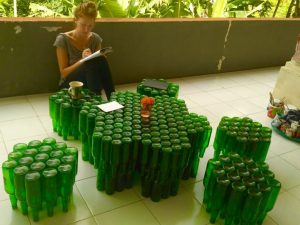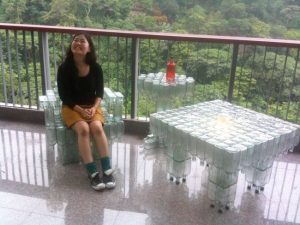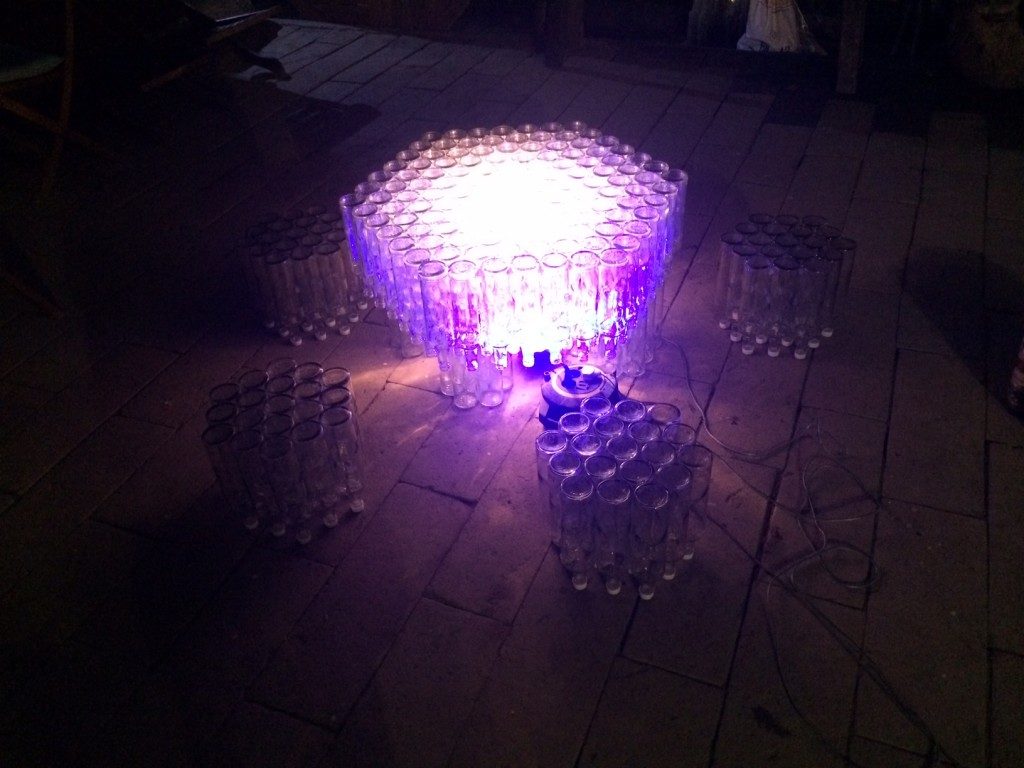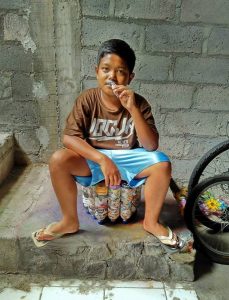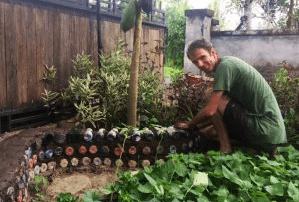So, what is an OpenSource, low-tech, invention? I’ve been saying how I am a Regenerative Inventor, innovating designs that serve the people and the planet outside of the Capitalist system. I’d like to share one of my inventions that I am most proud of.
Its what I call Milstein Modules . The technique, a little like LEGO, allows you to build furniture bottle furniture– specifically horizonal surface (next post I’ll get into the vertical invention!). I’ve literally walked into remote villages in Nepal and the Philippines, scavenged through their trash piles, and then made these things to the amazement of the villagers. I’ve done the same in big cities and top tier art galleries. No one ever looks at a bottle the same way again!
Starting with the Principles
All you need is a dozen bottles to start. It’s super simple, costs virtually nothing, and the materials are available to anyone on the planet. These aren’t just the facts, these are the very principles that guided the development. Kinda like the principles behind Steemit, the point is that this accessible and out of the capitalist system. Here are the main principles by hide the modules and my regenerative design.
- All materials are locally available
- Cost is negligible
- Skills required are negligible
- Equipment is locally available or negligible
- Cradle-to-Cradle
The Story behind the Invention
Milstein Modules are super simple, but it took three years of my work with thousands of bottles to get there.
The story begins in the Northern, Philippines, in a small indigenous village where I was stranded for four years (heh… you’ll have to follow me to get the full story! I will post shortly). In the Philippines, people like to drink gin. Like… A LOT. In these remote villages, there is simply was no way to dispose of the empty bottles. They pile up. Often, you’ll find piles of hundreds, even thousands of the bottles tucked in trash piles, under people’s houses, and stashed in forests.
I had managed to find an amazing space to call my home in one of the villages. It was basically a loft, with hard wood floors, overlooking the spectacular river valley (rent: 30$ a month!). The only problem: No furniture! And… no way to get furniture for hundreds of kilometers. I needed to furnish it somehow, so my girlf friend, Banca SIlva and I, started playing around with all these bottles. I used silicone, to join the bottles together to make a little stool. At first, I was doubtful it would hold our weight, or whether it would be strong enough. But… it was! Not only was it super strong and sturdy, it was actually comfortable.
I remember staring at the first one we made together, and thinking to myself, this is so beautiful and so use-full, the world is going to love this!
The first furniture we made with glass bottles. The gin bottles in the Philippines are absolutely perfect for building stuff like this– the bottles are basically square and fit together easily. The outputs that you make with them are similarily square and rectangular. Later we began to make them with Ecobricks (plastic bottles packed with plastic waste). As the Ecobrick phenomenon has spread around South East Asia, so too has my invention spread, with this being one of the most practical ecobrick outputs.
Making it Modular
Notice that at this point, I haven’t called them “Milstein Modules”. That’s because I hadn’t need to move my bottle furniture yet. After two years in the village, it was time to go to the next place. I was keen to take my furniture out and share it with my neighbours and friends in the community. In particular I had a big couch that I had made with the gin bottles. It was about 250m x 70cm x 70cm. I got four strapping farmer boys, to help me lift it and take it out. But…
They couldn’t lift it!
We couldn’t get it out the door let alone down the stairs. In the end, the couch, despite all its coolness, it couldn’t find its next home. We literally had to to take a hammer to it and shatter the bottles down the center. We managed to split it into two couch chairs, and at least we could get those out.
Those hammer blows, echoed long after in my mind. How to build practical furniture from bottles? Furniture that, despite the weight and fragility of glass, could be moved. The solution came as we moved into using circular bottles in our bottle construction.
Circles, when combined, make hexagons and triangles! Hexagons fit together two dimensionally just like honey comb. While, three dimensionally Hexagons and triangles fit together just like LEGO.
Modular design fulfills the essential principle of Regenerative Design, that creations must be Cradle-toCradle. In other words, that the next life of the creation is built in, so that when the object comes to its end, it doesn’t have to be trashed, but can instead be reused over and over. Milstein modules, either in glass or plastic bottles, are just this at two levels: one you can build over and over with the modules them, and second, the silicone joining bond, is such that it can be cut with a knife– and the bottles them cycled out to be used as a brick for cob construction.
Making it Modular
There are three main types of Milstein modules: Hexagons, triangles and MD modules. They fit together, and lock, when they are stacked vertically. This enables the building of chairs and tables. I will cover the MD module in a seperate post. They are named after teacher of peace Dan Milstein, one of the first patrons of the Ecobrick movement, who passed away in 2015.
Glass Bottle Modules
I love making these modules from glass bottles. Glass is beautiful. People often compare the bottle tables to works of art, and tell me that more expected to see such a creation in a Berlin gallery than a remote village. Even better, you can add lights into the center of the modules. Like the table and chairs below, you can switch these guys on to a subtle glow.
At this point Ecobricks had really taken off in the region where I was living. We had got it into the school system, and suddenly hundreds of schools had hundreds of ecobricks that they didn’t know quite what to do with. You can use ecobricks for outdoor cob constructions, but it takes hundreds or thousands of ecobricks, and more effort and coordination. We needed a quick and easy output for ecobrickers. It was then that I made my first Ecobrick Milstein module.
This time, we were using circular coke bottles to build with– so the result were hexagons! As you know, hexagons fit together to make honeycomb shapes real easy. The more hexagon modules a school made, the more cool stuff they could assemble! From chairs, to tables, to bigger tables, to stages! Students loved it.
Indonesian Viral Spread
I have brough the technique with me to Indonesia. Here, it has been the primary ecobrick output that we have encouraged (we’re getting back to cob garden building though!). The furniture modules are admittedly a jump for people to make an incorporate in their home and schools. There’s nothing like it in conventional furniture thinking (unless you’re really rich, and have some italian modern art designer furniture!). But, the modules are just so practical that sure and steady, the technique has spread.
Its pretty cool. I get photos sent to me from all around the world now of people who are using my invention to transform their plastic into ecobrick modules.
Making Milstein Modules
As I said at the beginning, my work is open source. So I encourage the replication and dissemination of the technique as much as possible. This post is getting pretty long. So I won’t go it detail on the making here. We do have resources up on www.Ecobricks.org/modules for how to make them. Although, the page needs to be updated with the latest refinements.


